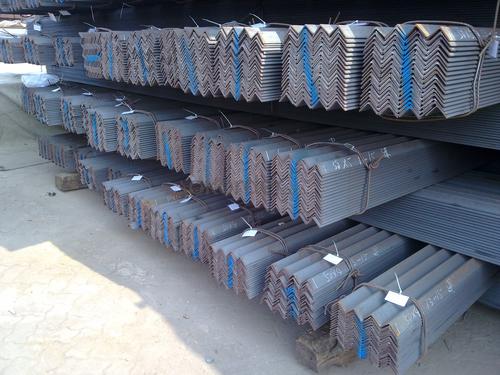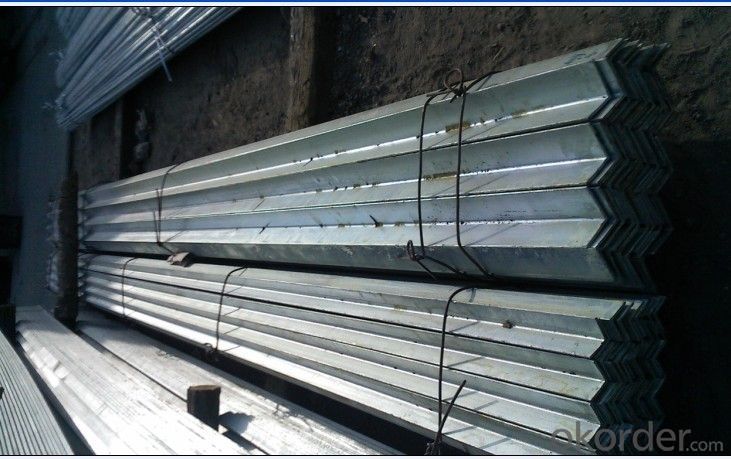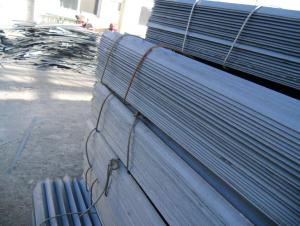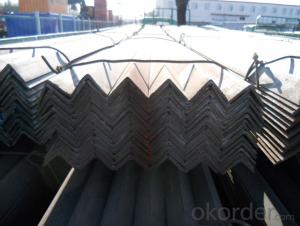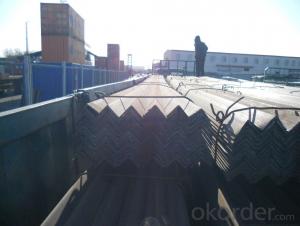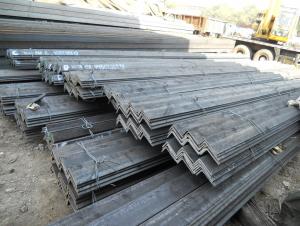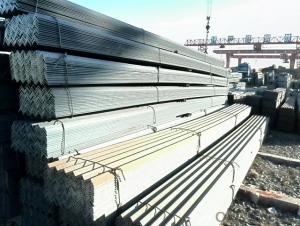Prime Low Carbon Steel Equal Angle Bars GB Standard
- Loading Port:
- Tianjin
- Payment Terms:
- TT or LC
- Min Order Qty:
- 100 m.t.
- Supply Capability:
- 20000 m.t./month
OKorder Service Pledge
OKorder Financial Service
You Might Also Like
OKorder is offering Prime Low Carbon Steel Equal Angle Bars GB Standard at great prices with worldwide shipping. Our supplier is a world-class manufacturer of steel, with our products utilized the world over. OKorder annually supplies products to African, South American and Asian markets. We provide quotations within 24 hours of receiving an inquiry and guarantee competitive prices.
Product Applications:
Prime Low Carbon Steel Equal Angle Bars GB Standard are ideal for structural applications and are widely used in the construction of buildings and bridges, and the manufacturing, petrochemical, and transportation industries
Product Advantages:
OKorder's Prime Low Carbon Steel Equal Angle Bars GB Standard are durable, strong, and wide variety of sizes.
Main Product Features:
· Premium quality
· Prompt delivery & seaworthy packing (30 days after receiving deposit)
· Can be recycled and reused
· Mill test certification
· Professional Service
· Competitive pricing
Product Specifications:
Manufacture: Hot rolled
Grade: Q195 – 235
Certificates: ISO, SGS, BV, CIQ
Length: 6m – 12m, as per customer request
Packaging: Export packing, nude packing, bundled
| EQUAL ANGLE STEEL | |||||
| size(mm) | a(mm) | a1(mm) | thickness(mm) | kg/m | length |
| 50*50*4 | 50 | 50 | 4 | 3.059 | 6m,9m,12m |
| 50*50*5 | 50 | 50 | 5 | 3.77 | 6m,9m,12m |
| 50*50*6 | 50 | 50 | 6 | 4.465 | 6m,9m,12m |
| 63*63*5 | 63 | 63 | 5 | 4.822 | 6m,9m,12m |
| 63*63*6 | 63 | 63 | 6 | 5.721 | 6m,9m,12m |
| 65*65*5 | 65 | 65 | 5 | 5 | 6m,9m,12m |
| 65*65*6 | 65 | 65 | 6 | 5.91 | 6m,9m,12m |
| 65*65*8 | 65 | 65 | 8 | 7.66 | 6m,9m,12m |
| 75*75*5 | 75 | 75 | 5 | 5.818 | 6m,9m,12m |
| 75*75*6 | 75 | 75 | 6 | 6.905 | 6m,9m,12m |
| 75*75*8 | 75 | 75 | 8 | 9.03 | 6m,9m,12m |
| 75*75*9 | 75 | 75 | 9 | 9.96 | 6m,9m,12m |
| 75*75*10 | 75 | 75 | 10 | 11.089 | 6m,9m,12m |
| 80*80*6 | 80 | 80 | 6 | 7.375 | 6m,9m,12m |
| 80*80*7 | 80 | 80 | 7 | 8.525 | 6m,9m,12m |
| 80*80*8 | 80 | 80 | 8 | 9.658 | 6m,9m,12m |
| 80*80*10 | 80 | 80 | 10 | 11.874 | 6m,9m,12m |
| 90*90*6 | 90 | 90 | 6 | 8.35 | 6m,9m,12m |
| 90*90*7 | 90 | 90 | 7 | 9.656 | 6m,9m,12m |
| 90*90*8 | 90 | 90 | 8 | 10.946 | 6m,9m,12m |
| 90*90*10 | 90 | 90 | 10 | 13.476 | 6m,9m,12m |
| 100*100*6 | 100 | 100 | 6 | 9.366 | 6m,9m,12m |
| 100*100*7 | 100 | 100 | 7 | 10.83 | 6m,9m,12m |
| 100*100*8 | 100 | 100 | 8 | 12.276 | 6m,9m,12m |
| 100*100*9 | 100 | 100 | 9 | 13.49 | 6m,9m,12m |
| 100*100*10 | 100 | 100 | 10 | 15.12 | 6m,9m,12m |
| 100*100*12 | 100 | 100 | 12 | 17.898 | 6m,9m,12m |
| 120*120*8 | 120 | 120 | 8 | 14.88 | 6m,9m,12m |
| 120*120*10 | 120 | 120 | 10 | 18.37 | 6m,9m,12m |
| 120*120*12 | 120 | 120 | 12 | 21.66 | 6m,9m,12m |
| 125*125*8 | 125 | 125 | 8 | 15.504 | 6m,9m,12m |
| 125*125*10 | 125 | 125 | 10 | 19.133 | 6m,9m,12m |
| 125*125*12 | 125 | 125 | 12 | 22.696 | 6m,9m,12m |
| 130*130*10 | 130 | 130 | 10 | 19.8 | 6m,9m,12m |
| 130*130*12 | 130 | 130 | 12 | 23.6 | 6m,9m,12m |
| 130*130*13 | 130 | 130 | 13 | 25.4 | 6m,9m,12m |
| 130*130*14 | 130 | 130 | 14 | 27.2 | 6m,9m,12m |
| 150*150*10 | 150 | 150 | 10 | 23 | 6m,9m,12m |
| 150*150*12 | 150 | 150 | 12 | 27.3 | 6m,9m,12m |
| 150*150*14 | 150 | 150 | 14 | 31.6 | 6m,9m,12m |
| 150*150*15 | 150 | 150 | 15 | 33.8 | 6m,9m,12m |
| 140*140*10 | 140 | 140 | 10 | 21.49 | 6m,9m,12m |
| 140*140*12 | 140 | 140 | 12 | 25.52 | 6m,9m,12m |
| 140*140*14 | 140 | 140 | 14 | 29.49 | 6m,9m,12m |
| 160*160*10 | 160 | 160 | 10 | 24.73 | 6m,9m,12m |
| 160*160*12 | 160 | 160 | 12 | 29.39 | 6m,9m,12m |
| 160*160*14 | 160 | 160 | 14 | 33.99 | 6m,9m,12m |
| 180*180*12 | 180 | 180 | 12 | 33.16 | 6m,9m,12m |
| 180*180*14 | 180 | 180 | 14 | 39.39 | 6m,9m,12m |
| 180*180*16 | 180 | 180 | 16 | 43.45 | 6m,9m,12m |
| 180*180*18 | 180 | 180 | 18 | 48.63 | 6m,9m,12m |
| 200*200*14 | 200 | 200 | 14 | 42.89 | 6m,9m,12m |
| 200*200*16 | 200 | 200 | 16 | 48.68 | 6m,9m,12m |
| 200*200*18 | 200 | 200 | 18 | 54.4 | 6m,9m,12m |
| 200*200*20 | 200 | 200 | 20 | 60.06 | 6m,9m,12m |
| 200*200*24 | 200 | 200 | 24 | 71.17 | 6m,9m,12m |
FAQ:
Q1: How many tons of steel products could be loaded in containers?
A1: Usually the steel products are delivered by bulk vessel because of the large quantity and the freight. However, there are no bulk vessel enter some seaports so that we have to deliver the cargo by containers. The 6m steel product can be loaded in 20FT container, but the quantity is changed according to the size, usually from 18tons to 25tons.
Q2: How do we guarantee the quality of our products?
A2: We have established an advanced quality management system which conducts strict quality tests at every step, from raw materials to the final product. At the same time, we provide extensive follow-up service assurances as required.
Q3: How soon can we receive the product after purchase?
A3: Within three days of placing an order, we will arrange production. The normal sizes with the normal grade can be produced within one month. The specific shipping date is dependent upon international and government factors, the delivery to international main port about 45-60days.
Images:

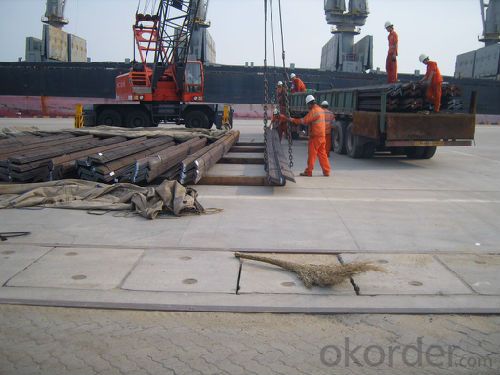
- Q: Can steel angles be used for transportation infrastructure projects?
- Indeed, transportation infrastructure projects can make use of steel angles. The construction industry frequently relies on steel angles for a range of purposes, including the development of bridges, highways, and railways. These angles offer vital support and stability to such structures, ensuring their strength and durability. Their versatility allows for easy fabrication and installation, making them an excellent selection for transportation infrastructure projects that prioritize strength and dependability. Moreover, steel angles possess a remarkable load-bearing capacity and resistance to environmental elements, guaranteeing the long-term safety and longevity of transportation infrastructure. As a result, steel angles find extensive use in transportation infrastructure projects across the globe.
- Q: How do steel angles compare to other structural materials?
- Steel angles are highly versatile and widely used in construction due to their strength, durability, and cost-effectiveness. Compared to other structural materials like wood or concrete, steel angles offer superior strength-to-weight ratio, allowing for lighter structural components without compromising structural integrity. Additionally, steel angles are resistant to fire, pests, and moisture, making them ideal for long-lasting and low-maintenance structures. Overall, steel angles are a reliable and efficient choice for various structural applications.
- Q: Can iron angle steel be welded with stainless steel angle steel?
- The best way is connected, steel angle iron punching stainless steel respectively. Use 8.8S high-strength screws to connect.
- Q: What are the limitations of using steel angles in high-temperature applications?
- One limitation of using steel angles in high-temperature applications is that steel has a relatively low melting point compared to other materials like refractory metals or ceramics. At high temperatures, steel can start to deform, lose its strength, and even melt, leading to structural failures. Additionally, steel can undergo significant thermal expansion and contraction, which can cause dimensional changes and potential cracking in the angles. Therefore, alternative materials with higher melting points and better resistance to thermal expansion may be more suitable for high-temperature applications.
- Q: How are steel angles used in construction?
- Steel angles are commonly used in construction to provide structural support and stability. They are often used as braces, struts, or beams to reinforce the framework of buildings, bridges, and other structures. Steel angles can also be used as corner supports, especially in the construction of walls and ceilings. Their versatility and strength make them an essential component in various construction applications.
- Q: What are the common surface treatments for steel angles to enhance corrosion resistance?
- To enhance the corrosion resistance of steel angles, there are various surface treatments commonly employed. These treatments encompass: 1. Galvanization: A highly favored method for safeguarding steel angles against corrosion, galvanization involves the application of a zinc layer through hot-dip galvanizing. This zinc coating acts as a barrier, effectively preventing moisture and corrosive substances from reaching the underlying steel. 2. Painting or Powder Coating: By applying a layer of paint or powder coating to the surface of steel angles, an additional protective layer is established against corrosion. This coating serves as a barrier, shielding the steel from exposure to moisture and other corrosive elements. Particularly useful in applications where aesthetics play a crucial role, this method offers a wide range of color options. 3. Phosphating: Phosphating entails the application of a thin layer of zinc or manganese phosphate to the surface of the steel angle. This treatment forms a protective layer that enhances corrosion resistance by acting as a barrier between the steel and corrosive substances. 4. Chromate Conversion Coating: This process involves immersing the steel angle in a solution containing chromates, resulting in the formation of a thin chromate conversion coating on the surface. This coating acts as a barrier, providing corrosion resistance against moisture and other corrosive elements. 5. Mechanical Finishing: To eliminate existing rust or scale from the surface of the steel angle, mechanical finishing techniques like shot blasting or sandblasting can be employed. This process enhances the adhesion of subsequent coatings and treatments, thereby improving corrosion resistance. It is important to consider that the selection of a surface treatment for steel angles relies on specific applications, environmental conditions, and the desired level of corrosion resistance. Consulting a corrosion specialist or industry professional can aid in determining the most suitable treatment for a given situation.
- Q: Can steel angles be used in electrical grounding applications?
- Yes, steel angles can be used in electrical grounding applications. Steel angles are commonly used in construction for their strength and durability. In electrical grounding applications, steel angles can be used to create grounding grids or grounding systems. These grids or systems help to prevent electrical shock hazards by providing a low-resistance path for electrical currents to flow to the ground. Steel angles are often used as structural components in these grounding systems due to their ability to withstand physical stress and their conductive properties. However, it is important to ensure that the steel angles are properly installed and connected to the electrical system in accordance with relevant codes and standards to ensure effective grounding and safety.
- Q: Are steel angles suitable for coastal or saltwater environments?
- Yes, steel angles are suitable for coastal or saltwater environments. They are widely used in various marine applications due to their excellent corrosion resistance properties. The alloying elements in steel angles, such as chromium and nickel, help to protect against rust and corrosion caused by exposure to saltwater or high humidity. Additionally, proper maintenance and coatings can further enhance their durability in these environments.
- Q: How do you prevent welding distortion in steel angles?
- To prevent distortion in steel angles during welding, there are several strategies that can be implemented: 1. Ensure proper welding technique by correctly setting welding parameters, such as voltage, current, and travel speed, to control heat input. This prevents excessive heating of the steel angles, which can cause distortion. 2. Prepare the steel angles before welding by cleaning surfaces to remove dirt, oil, or rust. Also, bevel the edges of the angles to create a V-groove joint. This allows for better penetration and reduces the risk of distortion. 3. Temporarily hold the steel angles in place using tack welds before final welding. Strategically place these tack welds to evenly distribute stresses during welding and minimize distortion. 4. Determine the most suitable weld sequence for the specific joint configuration. Start welding from the center and progress outwards, alternating sides to balance heat input. This helps avoid localized overheating and subsequent distortion. 5. Use fixtures or clamps to hold the steel angles in place during welding. This ensures they remain in the correct position and minimizes distortion caused by movement or displacement during welding. 6. Consider preheating the steel angles before welding to reduce the risk of distortion. Controlled post-weld heat treatment may also be applied to relieve residual stresses and minimize distortion. 7. Adjust the welding sequence if the steel angles are part of a larger assembly. This involves welding in a specific order to balance shrinkage forces and reduce overall distortion of the assembly. By implementing these measures, welding distortion in steel angles can be effectively prevented, resulting in high-quality welds and ensuring the structural integrity of the fabricated components.
- Q: What is the maximum length for a steel angle bracket?
- The maximum length for a steel angle bracket can vary depending on the specific design and manufacturer, but it generally ranges from 6 to 12 inches.
Send your message to us
Prime Low Carbon Steel Equal Angle Bars GB Standard
- Loading Port:
- Tianjin
- Payment Terms:
- TT or LC
- Min Order Qty:
- 100 m.t.
- Supply Capability:
- 20000 m.t./month
OKorder Service Pledge
OKorder Financial Service
Similar products
Hot products
Hot Searches



